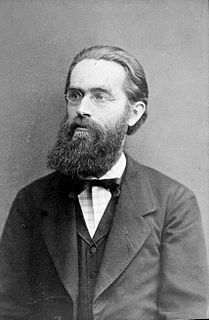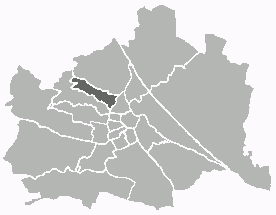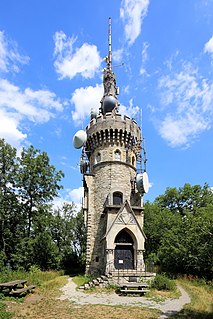The Hohe Warte is a hill in the 19th district of the city of Vienna, Döbling between Heiligenstadt and Unterdöbling. There is also a street with the same name. In the 19th century, a number of villas were built on the Hohe Warte because it offered good views of the surrounding areas. Today, the Hohe Warte is best known firstly as the site of the Zentralanstalt für Meteorologie und Geodynamik (Central Bureau for Meteorology and Geodynamics), which is also often referred to as the Hohe Warte because of its address, secondly for the former presidential villa of the Austrian Bundespräsident, and thirdly for the stadium Casino-Stadion Hohe Warte.

Vienna is the federal capital and largest city of Austria, and one of the nine states of Austria. Vienna is Austria's primate city, with a population of about 1.9 million, and its cultural, economic, and political centre. It is the 7th-largest city by population within city limits in the European Union. Until the beginning of the 20th century, it was the largest German-speaking city in the world, and before the splitting of the Austro-Hungarian Empire in World War I, the city had 2 million inhabitants. Today, it has the second largest number of German speakers after Berlin. Vienna is host to many major international organizations, including the United Nations and OPEC. The city is located in the eastern part of Austria and is close to the borders of the Czech Republic, Slovakia, and Hungary. These regions work together in a European Centrope border region. Along with nearby Bratislava, Vienna forms a metropolitan region with 3 million inhabitants. In 2001, the city centre was designated a UNESCO World Heritage Site. In July 2017 it was moved to the list of World Heritage in Danger.
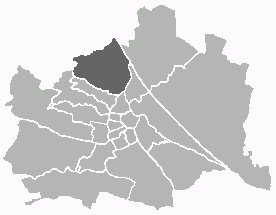
Döbling is the 19th District in the city of Vienna, Austria. It is located on the north end from the central districts, north of the districts Alsergrund and Währing. Döbling has some heavily populated urban areas with many residential buildings, and borders the Vienna Woods. It hosts some of the most expensive residential areas such as Grinzing, Sievering, Neustift am Walde and Kaasgraben and is also the site of a large number of Heurigen restaurants. There are also some large Gemeindebauten, including Vienna's most famous one, the Karl-Marx-Hof.

Heiligenstadt was an independent municipality until 1892 and is today a part of Döbling, the 19th district of Vienna.
In 1872, the Zentralanstalt für Meteorologie und Geodynamik relocated from Wieden to the Hohe Warte; its new home had been built by Heinrich von Ferstel between 1870 and 1872. The institute is responsible inter alia for Austria’s daily weather reports. In 1957, the complex on the Hohe Warte was greatly expanded, and in 1967 and 1973 a radar tower, a facility for filling hot air balloons and a new office tower were added. This office tower today also houses a large library with a collection specialising in meteorology and geophysics.
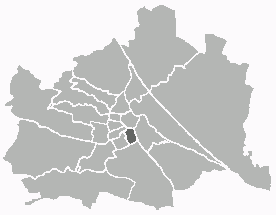
Wieden is the 4th municipal District of Vienna, Austria. It is near the centre of Vienna and was established as a district in 1850, but its borders were changed later. Wieden is a small region near the city centre. After World War II, Wieden was part of the Soviet sector of Vienna for 10 years.

Heinrich Freiherr von Ferstel was an Austrian architect and professor, who played a vital role in building late 19th-century Vienna.

Radar is a detection system that uses radio waves to determine the range, angle, or velocity of objects. It can be used to detect aircraft, ships, spacecraft, guided missiles, motor vehicles, weather formations, and terrain. A radar system consists of a transmitter producing electromagnetic waves in the radio or microwaves domain, a transmitting antenna, a receiving antenna and a receiver and processor to determine properties of the object(s). Radio waves from the transmitter reflect off the object and return to the receiver, giving information about the object's location and speed.

The Hohe Warte is also the site of a well-known sporting facility in the form of the Casino-Stadion Hohe Warte. This stadium is the home ground of the First Vienna FC, which has been crowned Austrian champion six times, the Austrian national rugby team and the Raiffeisen Vikings Vienna, the Austrian and European champions in American Football. When it was opened in 1921, the stadium was the largest and most modern football stadium in continental Europe. International matches such as between Austria and Italy in 1923 were watched by as many as 80,000 people on the largest open viewing area in Europe at the time.
Hohe Warte Stadium is a multi-purpose stadium in Vienna, Austria. It is located on the Hohe Warte hill in Heiligenstadt, a northern suburb in the 19th Viennese district of Döbling. Primarily a football venue and the home of First Vienna FC, it has also occasionally played host to Austrian international rugby union matches and the Vienna Vikings American Football team.

First Vienna FC is an Austrian association football club based in the Döbling district of Vienna. Established on 22 August 1894, it is the country's oldest team and has played a notable role in the history of the game there. It is familiarly known to Austrians by the English name Vienna.
Since the stadium was renovated in 2005-2006, it can now seat 5500 fans. The City of Vienna now prohibits the use of the open viewing area.

The sporting arena on the Hohe Warte also played host to opera performances and boxing matches in the 1920s. The first open-air opera performance in Vienna’s history took place here in 1924 when Pietro Mascagni conducted the opera Aida. The audience was arranged on an “amphitheatre-like parquet”; 17,000 could sit and a further 8,000 stood to watch the performance. The stage was almost 50 metres wide and 35 metres deep and was filled by a cast including soloists, a 200-strong choir and 700 extras. In 1935, a second season of opera was put on, featuring performances of Aida, Pagliacci und Cavalleria Rusticana. Live camels and elephants were used in performances that were watched by 18,000 seated and 14,000 standing audience members. [1]

Opera is a form of theatre in which music has a leading role and the parts are taken by singers, but is distinct from musical theater. Such a "work" is typically a collaboration between a composer and a librettist and incorporates a number of the performing arts, such as acting, scenery, costume, and sometimes dance or ballet. The performance is typically given in an opera house, accompanied by an orchestra or smaller musical ensemble, which since the early 19th century has been led by a conductor.

Boxing is a combat sport in which two people, usually wearing protective gloves, throw punches at each other for a predetermined amount of time in a boxing ring.

Aida is an opera in four acts by Giuseppe Verdi to an Italian libretto by Antonio Ghislanzoni. Set in the Old Kingdom of Egypt, it was commissioned by Cairo's Khedivial Opera House and had its première there on 24 December 1871, in a performance conducted by Giovanni Bottesini. Today the work holds a central place in the operatic canon, receiving performances every year around the world; at New York's Metropolitan Opera alone, Aida has been sung more than 1,100 times since 1886. Ghislanzoni's scheme follows a scenario often attributed to the French Egyptologist Auguste Mariette, but Verdi biographer Mary Jane Phillips-Matz argues that the source is actually Temistocle Solera.
To the north of the stadium, the Döblinger Bad provides both an open-air and an indoor swimming pool.
The Hohe Warte can be reached with metro line 4 (the U4) and tram lines 37 and D.
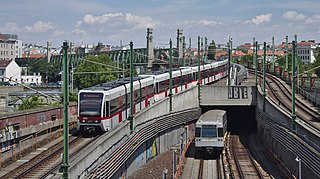
The Vienna U-Bahn, where U-Bahn is an abbreviation of the German term Untergrundbahn, is one of the two rapid transit (metro) systems for Vienna, Austria. The second system is the Vienna S-Bahn. With the October 2013 opening of the 4.2 kilometers (2.6 mi), three-station extension of the U2 line, the five-line U-Bahn network consists of 78.5 kilometers (48.8 mi) of route, serving 98 stations. It is the backbone of one of the best performing public transport systems worldwide according to UITP in June 2009. More than 1.3 million passengers rode the Vienna U-Bahn every day in 2009, and 567.6 million passengers used the U-Bahn in 2011, which declined to 428.8 million passengers in 2013. The network is undergoing expansion and rolling stock renewal. Since 1969, 200 million euros have been invested annually in the extension of the Vienna U-Bahn.

Wiener Linien is the company running most of the public transit network in the city of Vienna, Austria. It is part of the city corporation Wiener Stadtwerke Holding AG.
Coordinates: 48°14′58″N16°21′28″E / 48.24944°N 16.35778°E

A geographic coordinate system is a coordinate system that enables every location on Earth to be specified by a set of numbers, letters or symbols. The coordinates are often chosen such that one of the numbers represents a vertical position and two or three of the numbers represent a horizontal position; alternatively, a geographic position may be expressed in a combined three-dimensional Cartesian vector. A common choice of coordinates is latitude, longitude and elevation. To specify a location on a plane requires a map projection.
